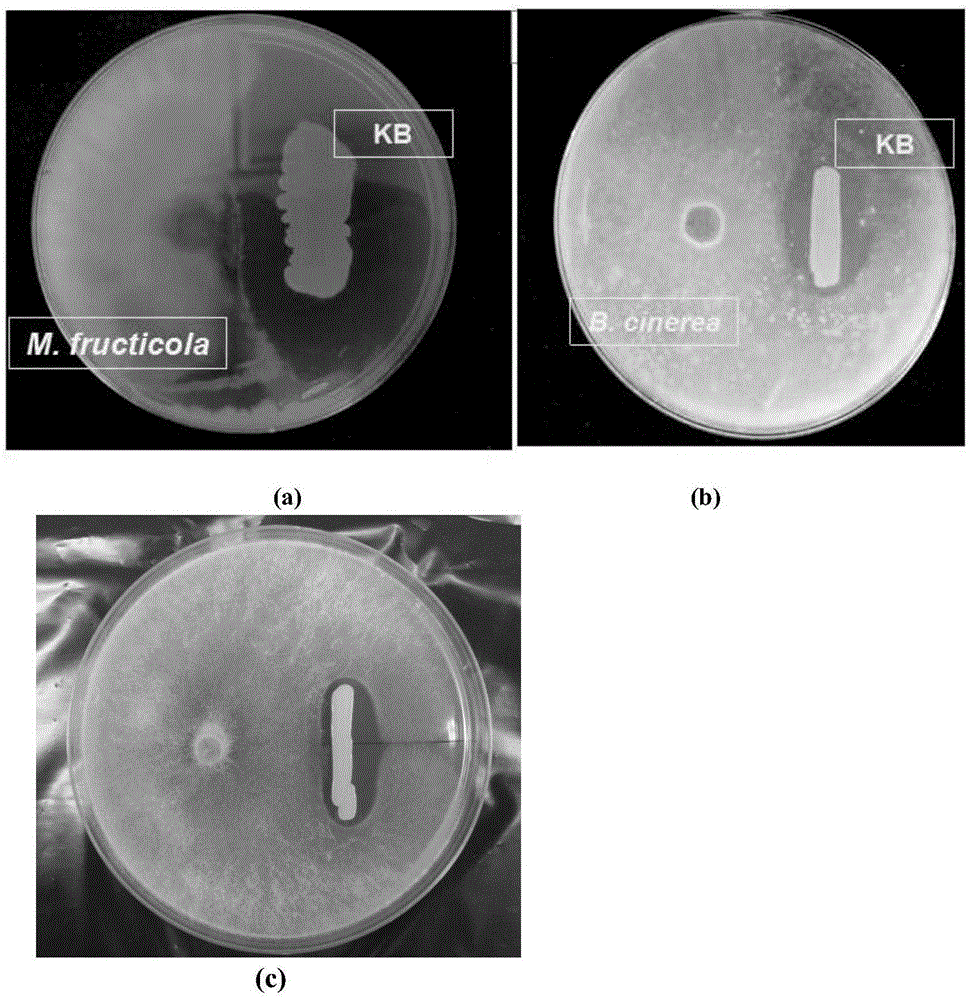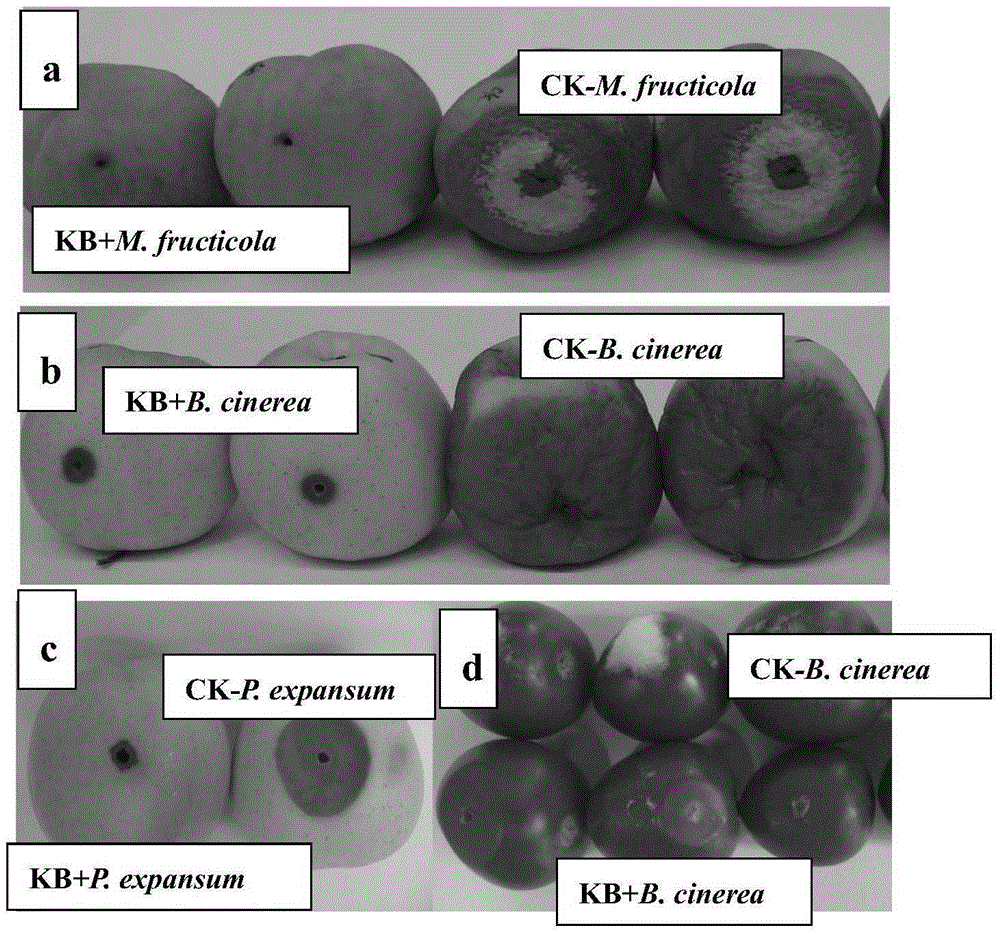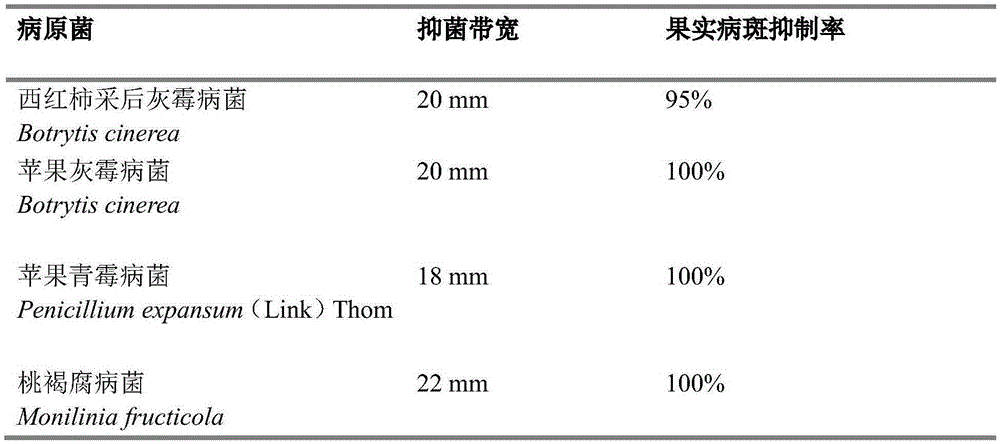A strain of Bacillus amyloliquefaciens that inhibits fungi and its application
A technology of Bacillus amyloliquefaciens and Bacillus, which is applied in the direction of application, chemicals and bacteria for biological control, and can solve the problems of Bacillus amyloliquefaciens, aggravation, shedding, etc.
- Summary
- Abstract
- Description
- Claims
- Application Information
AI Technical Summary
Problems solved by technology
Method used
Image
Examples
Embodiment 1
[0046] Isolation and strain identification of Bacillus amyloliquefaciens KB of the present invention
[0047] 1. Sample collection
[0048] Collect peaches and kiwis from organic orchards in northern China.
[0049] 2. Isolation and screening of strains and antagonistic screening
[0050] Strains were isolated from organic fruits, and separated by conventional gradient dilution coating. Four kinds of media, LB, NA, KB, and CM0002, were cultured at 28°C respectively, and bacteria with large differences in colony morphology and pure culture were selected. Purified and preserved on LB medium, and performed antagonistic primary screening and multiple re-screening with Peach brown rot as the target pathogen, and finally a bacterial strain with strong antibacterial activity was obtained, which was named KB.
[0051] 3. Identification of strains
[0052] The morphological, physiological and biochemical characteristics and some conservative sequences of the strain KB were analyzed. Refer to th...
Embodiment 2
[0055] Determination of the antibacterial spectrum of Bacillus amyloliquefaciens KB according to the present invention
[0056] Test pathogens:
[0057] Peach brown rot fungus-Moniliniafructicola (wint.) Rehm);
[0058] Botrytis cinerea-Botrytis cinerea Per.exFr;
[0059] Botrytis cinerea (Botrytiscinerea Per.exFr);
[0060] Postharvest apple penicillium pathogen-Penicillium expansum Link (Penicillium expansum Link, 1809)
[0061] Postharvest peach brown rot pathogen, postharvest apple gray mold, and apple postharvest penicillium were selected as indicator fungi, and the plate confrontation culture method was adopted.
[0062] The specific operation is as follows: Bacillus amyloliquefaciens (Bacillus amyloliquefaciens) KB strain was cultured on LB medium at 28°C for 48h. Plant pathogenic fungi were cultured on a PDA plate at a constant temperature of 25°C for 3-4 days. From the edge of the colony, a sterile stainless steel punch with a diameter of 0.7 cm was used to make a bacteria-carry...
Embodiment 3
[0072] Under storage conditions, the experiment on the prevention and control effect of Bacillusamyloliquefaciens KB on postharvest diseases of apples and tomatoes:
[0073] 1. After the apple is picked, it is treated with KB bacterial liquid (the concentration of bacterial liquid is 10 6 cfu / ml, 10 7 cfu / ml, 10 8 cfu / ml, 10 9 cfu / ml) soaking for 30-60 seconds, air-dry at room temperature, and then store in the dark at a temperature of 1-2°C and a relative humidity of 90-95%. After storage for 10 months, compared with the control group, when the concentration of the bacterial solution is 10 6 The control effect of cfu / ml is 45%, when the concentration of bacterial solution reaches 10 7 When cfu / ml, its control effect reaches 65%, when the concentration of the bacterial solution reaches 10 8 cfu / ml and 10 9 When cfu / ml, its control effect is 70% and 75% respectively.
[0074] 2. After the tomatoes are picked, they are treated with KB bacteria liquid (the concentration of the bacteria...
PUM
| Property | Measurement | Unit |
|---|---|---|
| diameter | aaaaa | aaaaa |
| diameter | aaaaa | aaaaa |
| control rate | aaaaa | aaaaa |
Abstract
Description
Claims
Application Information
 Login to View More
Login to View More - R&D
- Intellectual Property
- Life Sciences
- Materials
- Tech Scout
- Unparalleled Data Quality
- Higher Quality Content
- 60% Fewer Hallucinations
Browse by: Latest US Patents, China's latest patents, Technical Efficacy Thesaurus, Application Domain, Technology Topic, Popular Technical Reports.
© 2025 PatSnap. All rights reserved.Legal|Privacy policy|Modern Slavery Act Transparency Statement|Sitemap|About US| Contact US: help@patsnap.com



